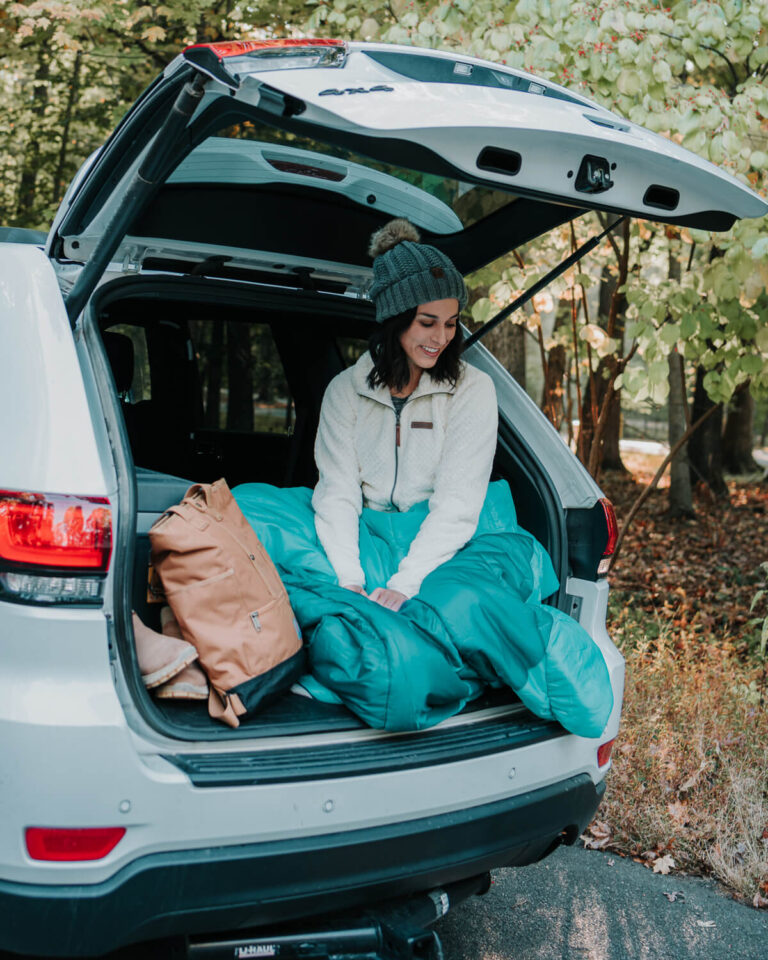15 Tips for Keeping Warm in a Tent
Wondering how to stay warm in a tent in winter? Call me crazy, but I’ve grown to love tent camping during the cooler months. There’s nothing like cozying up by the campfire or enjoying a warm cup of coffee on a crisp morning.
I haven’t always been a fan of winter camping, though! I went camping in cold weather without being adequately prepared on many occasions before coming to terms with the fact that I needed to put forth more effort to be comfortable.
In this blog post, I’m sharing 15 tips for keeping warm in a tent! These suggestions will help you enjoy your next camping trip on a cold night instead of regretting everything (trust me, I’ve been there).
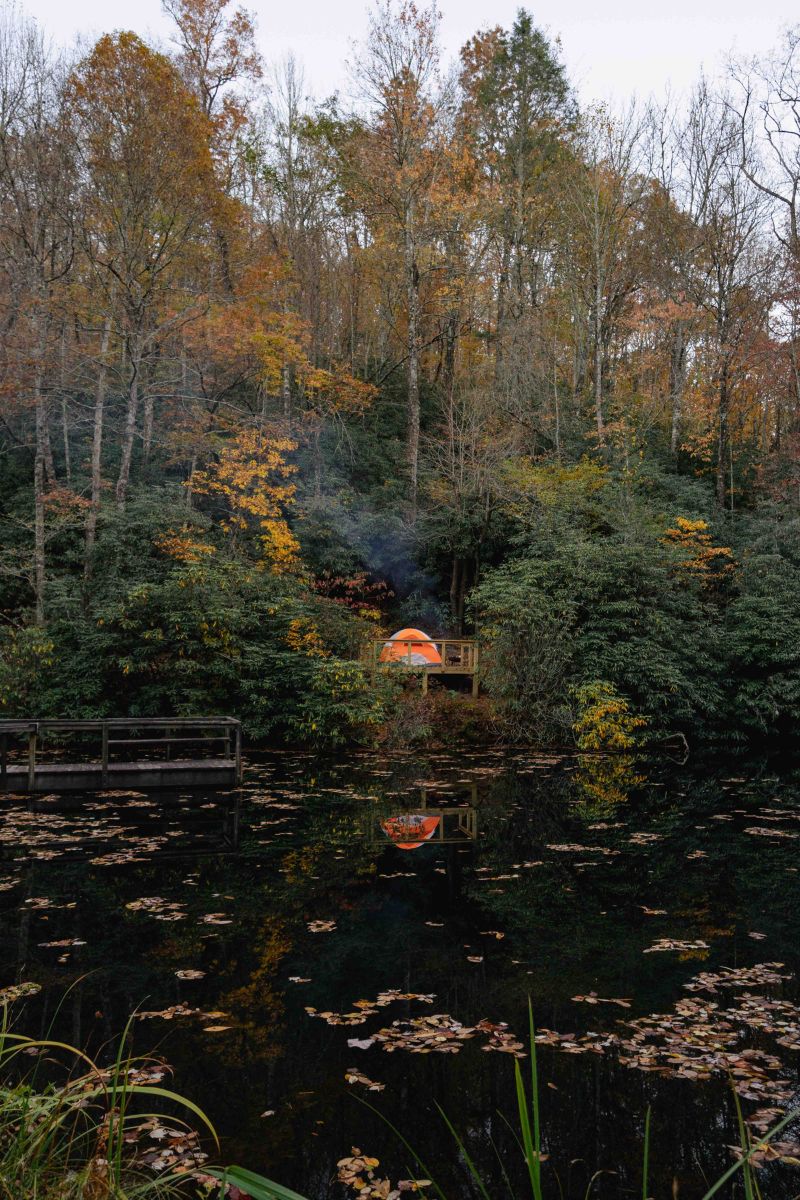
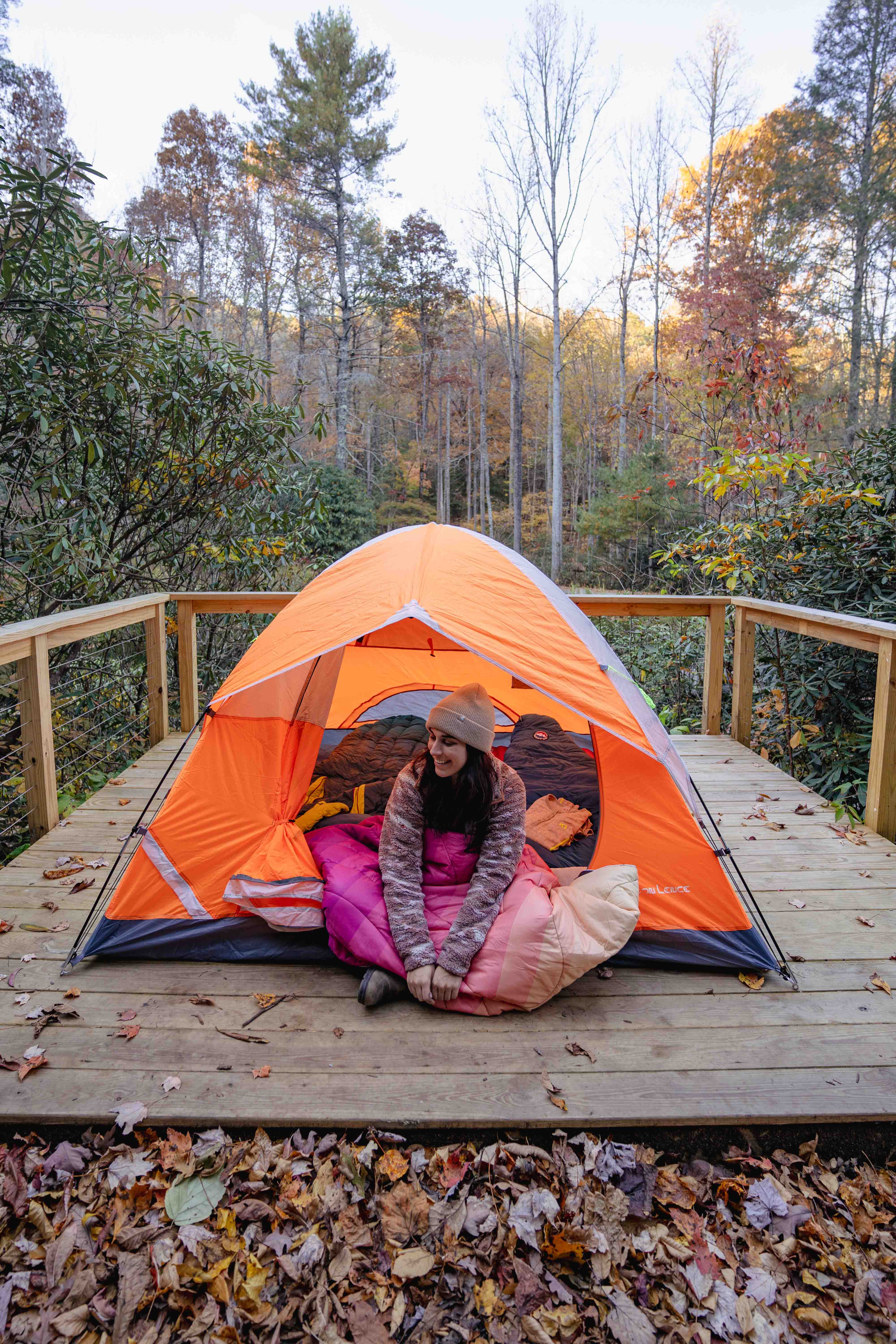
Disclaimer: This page may contain affiliate links where I earn a small commission at no extra cost to you.
How to Stay Warm in a Tent Without Electricity
Although they make heaters to go inside tents, you can stay warm in a tent without electricity or gas. That’s not to say that using a tent-friendly heater is never worth it, but factors such as your sleeping bag, sleeping pad, and clothing are far more effective at keeping you warm than a heater.
In my opinion, the cons to putting a heater in a tent outweigh the benefits when you consider things like added weight, safety concerns, heat output (most tents aren’t insulated well enough to retain heat), and the fact that you’ll need electrical hookups or fuel.
I’m all about convenience when camping, so I’ll take whatever measures necessary to avoid taking extra equipment. These cold-weather camping hacks will help to keep you warm without electricity!
# 1: Invest in a good sleeping bag
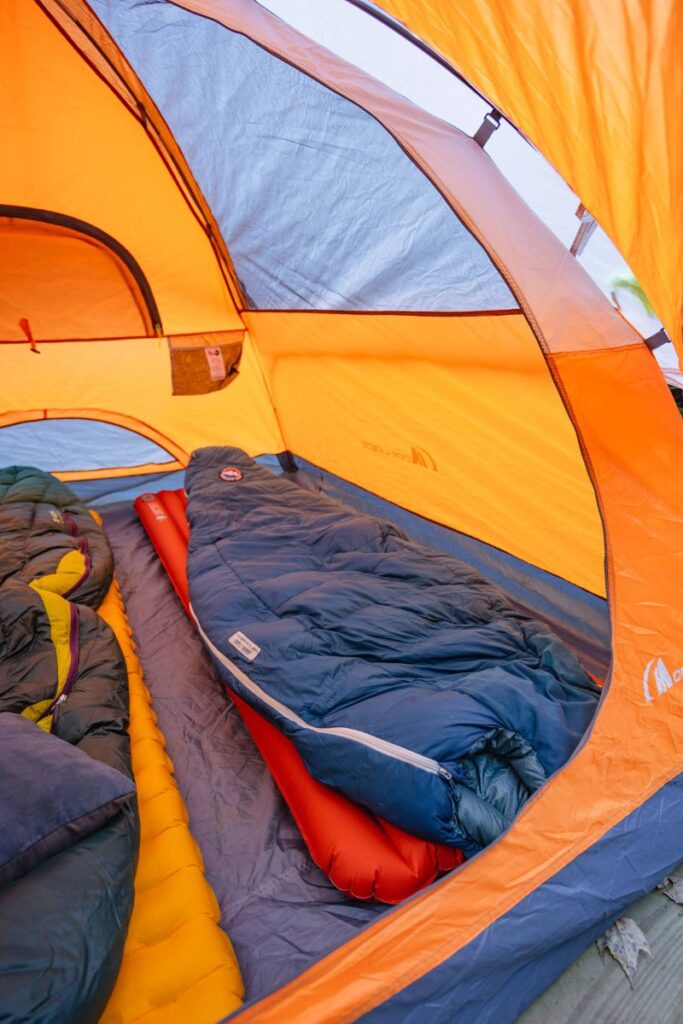
Proper insulation is the BEST way to *stay* warm. External heat sources, such as hand warmers, provide temporary relief from the cold. You’ll lose body heat to the ground when camping in cold weather. Therefore, your sleep system matters!
Choosing a sleeping bag can be difficult. I remember agonizing over temp ratings and material (down vs synthetic) when I was in the market for a new sleeping bag. I ended up purchasing the Big Agnes Sidewinder SL 20 Sleeping Bag and love it. It’s a down bag with a temperature rating of 20°F that I use for camping and backpacking year-round.
Material (down vs synthetic)
There are pros and cons to down and synthetic fill, which means the “better” option depends. Synthetic insulation is more affordable, but down insulation is more durable (with proper care) and warmer than synthetic. However, down does not perform well when wet.
A down sleeping bag is ideal for camping in cold, dry conditions. If you’re camping in wet conditions, synthetic is the way to go because it dries faster and continues to insulate when wet. You might consider trying a sleeping bag with a down/synthetic blend if you can’t find a down or synthetic bag that suits your needs.
Pro tip: Whether you have a down or synthetic bag, don’t leave your sleeping bag in its stuff sack unless absolutely necessary (such as when you’re backpacking). The compression will negatively impact the bag’s fill and loftiness over time.
Temperature rating
It’s important to know that temperature ratings for sleeping bags are more complex than the number on the bag’s label. You also have to keep in mind that temperature ratings are estimates. Just because you have a 20-degree bag doesn’t necessarily mean you’ll be comfortable in it at 20 degrees.
Oddly enough, there are different rating systems for women’s bags and men’s bags, so there’s that. Women’s bags get a comfort rating (the temperature at which a cold sleeper might be comfortable), and men’s bags get a lower limit rating (the temperature at which a warm sleeper might be comfortable). TL;DR: A woman’s 20-degree bag is likely warmer than a man’s 20-degree bag.
Even though it’s confusing, the rating system can help you figure out what bag best suits your needs. If you already have a sleeping bag that might not work for cooler temps and don’t want to buy a new bag (because expensive!), you can add a sleeping bag liner — this particular option can add up to 25°F of warmth.
# 2: Invest in a good sleeping pad
Sleeping pads have something called an R-value. A higher R-value means it does a better job of insulating you from the ground and vice versa. Pads with an R-value of 3-4 are good 3-season options. If you plan to camp at 15°F or lower, look at bags with an R-value higher than 4. You can also stack pads to increase the R-value if you already own multiple sleeping pads with lower R-values.
I always use my Big Agnes Insulated Air Core Ultra Sleeping Pad when camping. It’s also great for backpacking because it packs down well and is lightweight! The insulated version has an R-value of 4.5, making it a perfect all-season option.
# 3: Fill an uninsulated water bottle with hot water
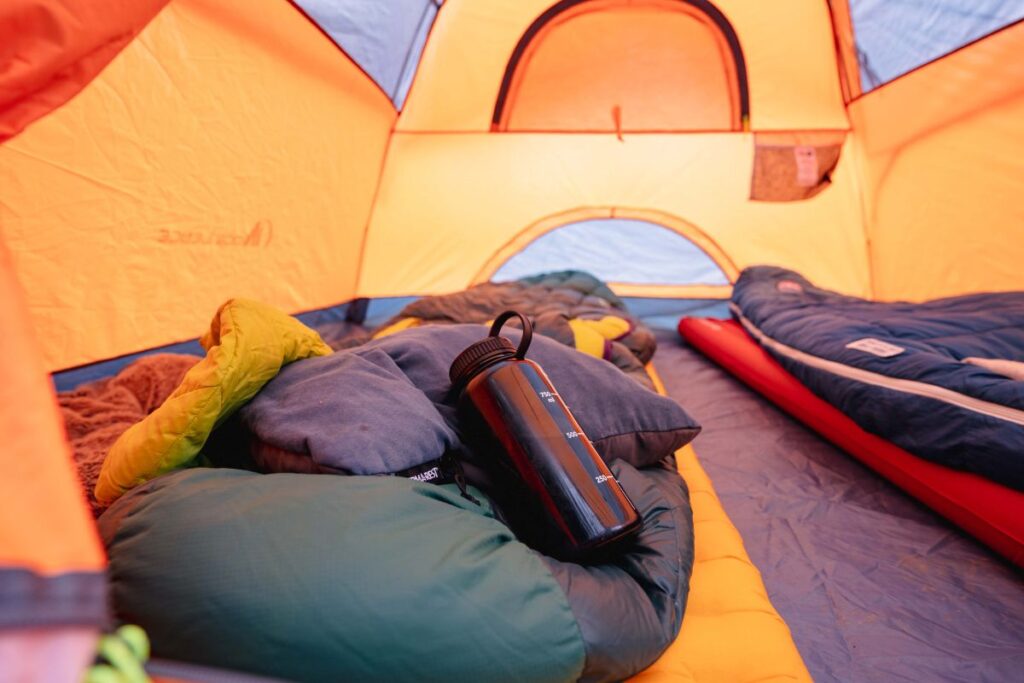
Filling a water bottle with warm water is one of my favorite quick hacks for some added warmth when I’m about to go to bed, and it’s so easy! All you have to do is boil some water and carefully pour it into an uninsulated water bottle. The uninsulated part is key because you want the bottle to release heat — a Nalgene is perfect.
Cozying up with this extra heat source in your sleeping bag feels amazing on a cold evening. While this isn’t the most long-lasting method for gaining heat (it will put off warmth for a few hours), it’s easy to repeat as needed.
# 4: Sleep in the base layers you plan to wear the next day
I highly recommend changing into a pair of fresh, dry base layers before bed. I like to sleep in whatever base layers I plan to wear the next day to avoid stripping down in the cold the next morning. Merino wool base layers are ideal because merino wool is insulating, water resistant, and softer than regular wool.
It’s a good idea to keep any clothing that will directly contact your body the next day in your sleeping bag (if you’re not already wearing it) while you sleep so that they stay warm from your body heat instead of turning into popsicles overnight. Whatever you do, don’t leave the clothes you plan to wear the following day out in your tent or car on a cold evening. I promise that putting them on will be painful (unfortunately, I am speaking from experience).
# 5: Put hand warmers in your sleeping bag
Similar to the water bottle trick, disposable hand warmers are a quick way to warm yourself up! If you toss a few in the bottom of your bag, they’ll help keep your feet (which should be in wool socks) extra toasty.
Electronic hand warmers are great too, but don’t put them in your sleeping bag—this could damage your bag, or worse, cause burns! These are better used in your pockets throughout the day to keep your hands warm.
# 6: Bring an extra blanket
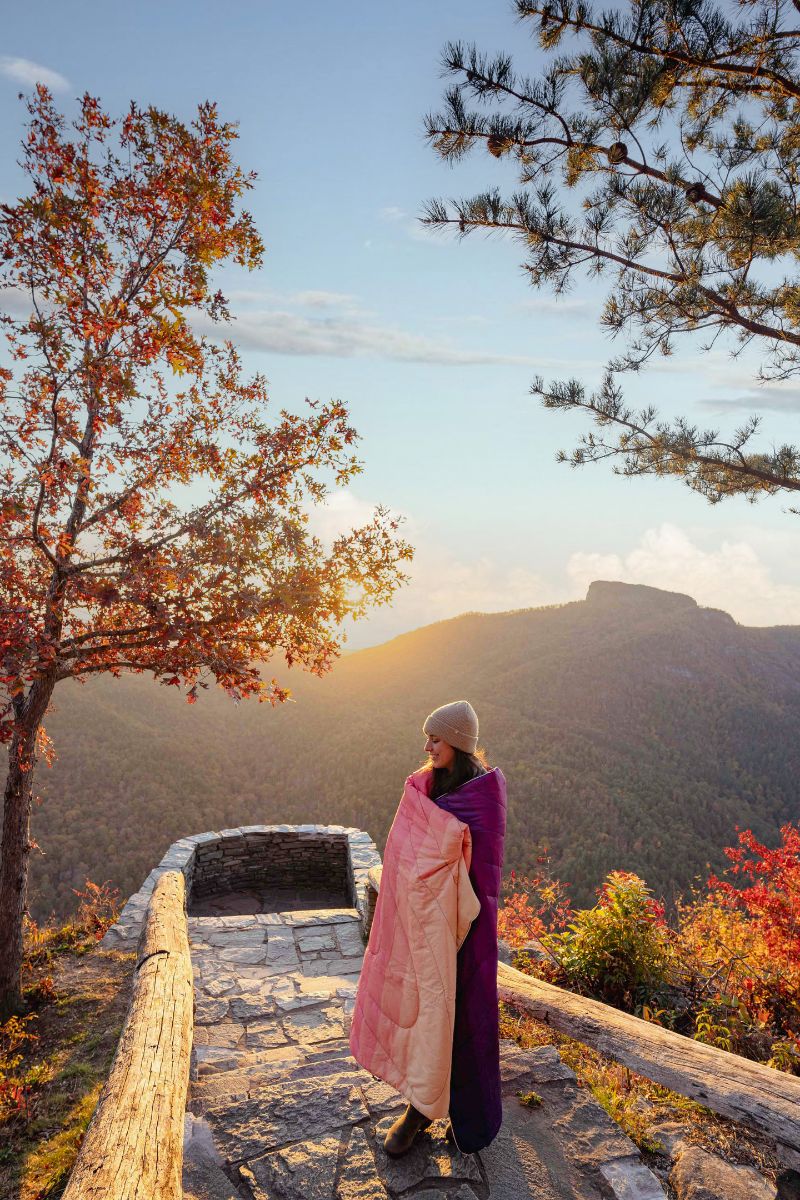
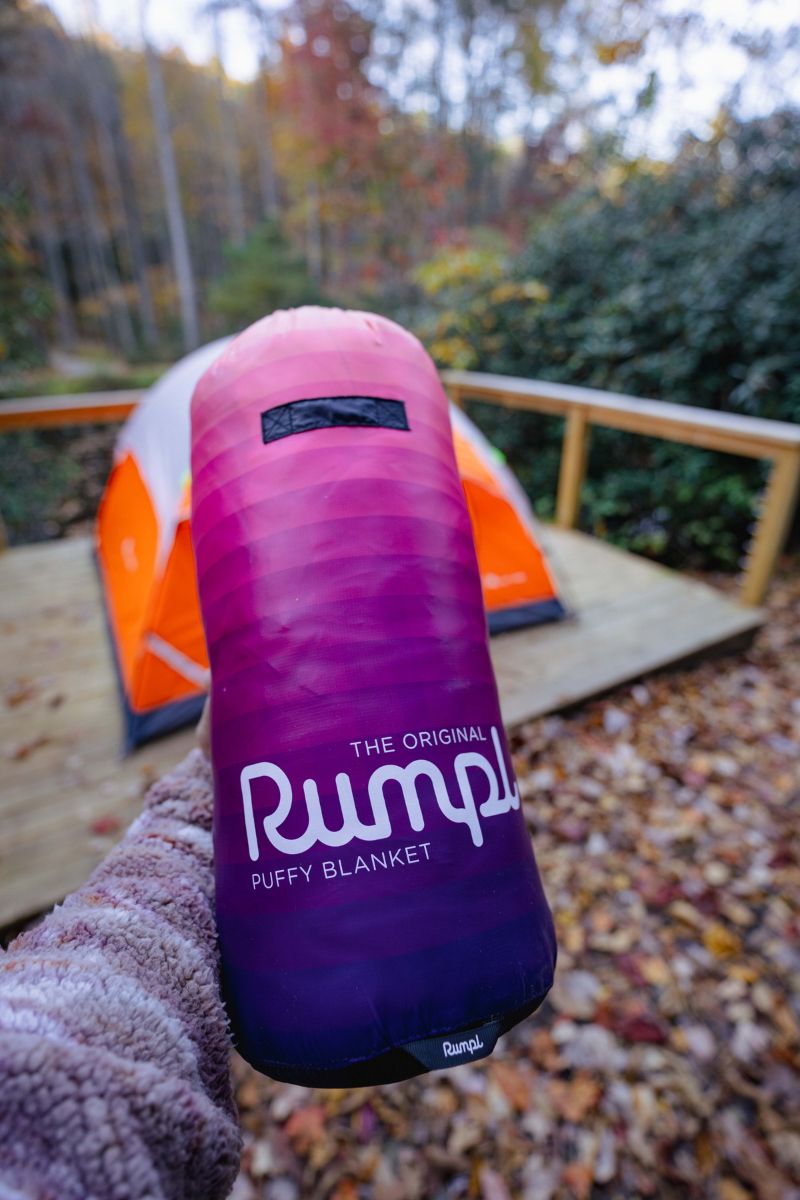
An extra blanket comes in handy for camping when it’s cold outside! I love to wrap up in my Rumpl blanket on cool mornings and while I sit by the campfire. I’ve started layering my Rumpl over my sleeping bag on extra chilly nights because it helps keep my head, neck, and hands warm.
Their camp blankets are great because they’re lightweight and super warm. They come in many beautiful designs and are made of recycled materials, which makes them even better! I have a one-person blanket, and it’s the perfect size.
Read More: Car Camping Essentials
# 7: Don’t forget to pack wool socks, gloves, a beanie, and a neck warmer
This may seem like a no-brainer, but simple items like wool socks, gloves, a beanie, and a neck warmer are easy to forget when you pack.
Keeping your extremities warm when it’s cold is incredibly important, so it’s crucial to remember these things. They come in handy for keeping warm in a tent!
# 8: Use a tent rug or footprint
While you shouldn’t rely on something like a tent rug or footprint for keeping warm in a tent (focus on your clothing and sleep system for that!), these items can provide added protection from the elements and don’t take up much space.
A footprint (or tarp) protects the bottom of your tent and prolongs its life. Also, it creates an additional layer between you and the ground, which can help offset the cold from the ground. Another option to reduce the cold air coming through the bottom of your tent is a rug.
# 9: Build a campfire
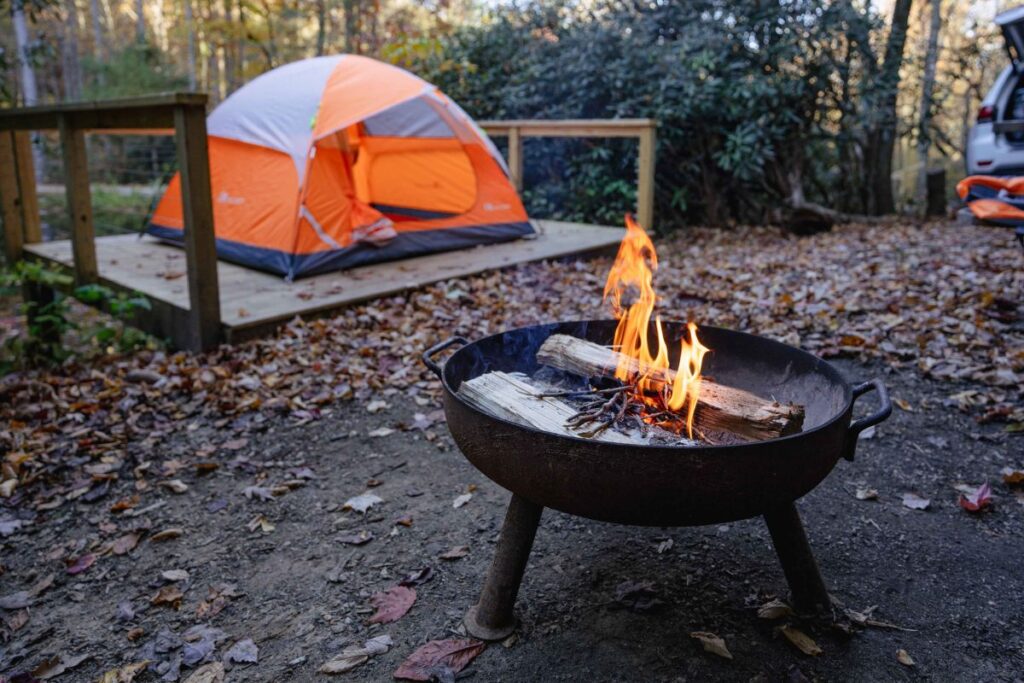
Building a campfire isn’t difficult if you know what you’re doing, but it can be tricky if you’ve never done it. It took me a couple of camping trips to get the hang of it. I recommend practicing your campfire-building skills on a trip when you’re not depending on fire for heat.
Make sure you have the supplies necessary to build a campfire: tinder, kindling, firewood, and a lighter. I like keeping a few fire starters handy because they’re cheap and make the fire-building process move faster.
Also, remember to follow restrictions (don’t build a campfire if there’s a fire ban) and never leave a fire unattended! Always extinguish your fire by drowning it with water before going to bed – I always pack extra water for this when dispersed camping.
# 10: Be mindful of where you set up camp
You know that feeling when it’s freezing out, and you finally step into the sun after being in the shade? It feels lovely! Feeling the sun hit your tent is similar, so I prefer to position my tent so that the sun will hit it in the morning when it’s cold. However, this isn’t always the best option (or an option at all), depending on where I’m camping.
If it’s windy, I’m going to be less concerned about sunlight and focused on finding a campsite that offers protection from the wind. Also, I wouldn’t pick an unlevel campsite just to get some morning sun. Assess the environment and use your best judgment to select a good campsite!
# 11: Prep good cold-weather food in advance
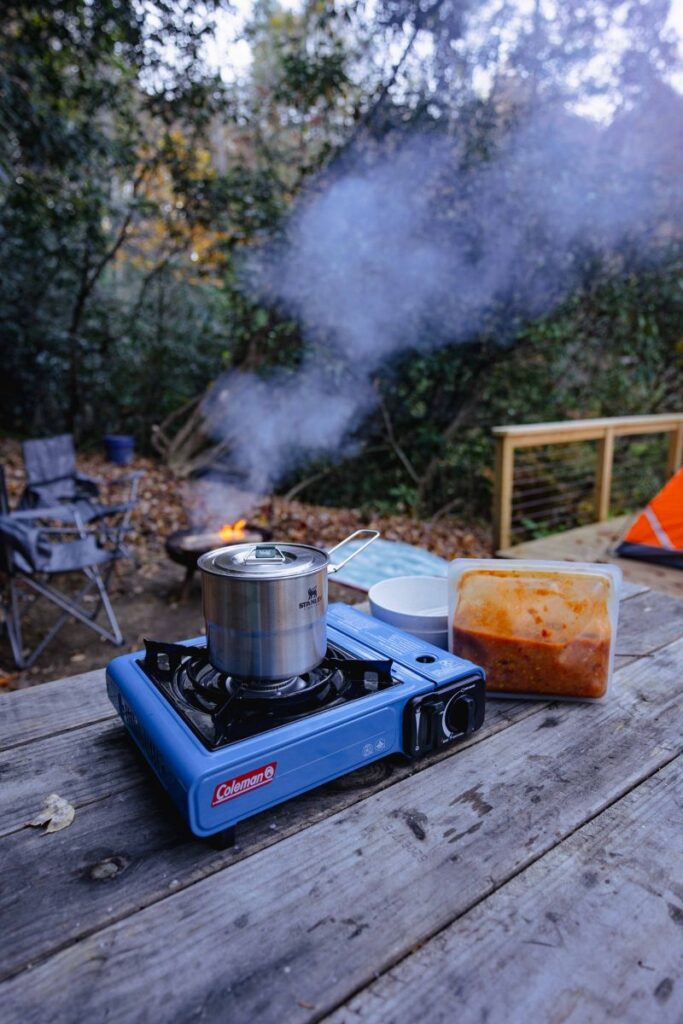
I love a good, hearty camping meal, but I don’t particularly enjoy the process of preparing a meal in the cold. Making soup at home, storing it in a Stasher bag, and taking it camping with you is the best way to have a hot meal with minimal effort! All you have to do at camp is heat it up and add toppings.
Here are more easy camp food ideas for the cooler months (I usually just search for recipes on Pinterest):
- Breakfast: oatmeal, pancakes, breakfast sandwiches
- Lunch: I’ll usually do a no cook option for lunch such as a PB&J or meat, cheese, and crackers with some hummus and veggies
- Dinner: turkey (or veggie) chili, beef stew, white chicken chili, taco soup
# 12: Make sure your tent has good ventilation
I’ve mentioned the word insulation roughly a million times in the blog post (or at least it feels that way), so bringing up ventilation may seem counterintuitive.
Why does tent ventilation matter? Because it helps keep your gear inside dry! Moisture will get trapped inside if you seal your tent too much, and we don’t want that. Take steps to prevent condensation in your tent.
If you’re curious about warm tents for winter, look into a 4-season tent. I would follow the other techniques listed in this post before purchasing a 4-season tent if you’re going on the occasional winter camping trip; however, you may find that it’s a worthwhile investment if you plan to camp in cold weather frequently.
# 13: Pay attention to your body heat
Paying attention to your body heat is critical for keeping warm in a tent! The tips in this post will help you maintain your body heat in cold weather. However, you should familiarize yourself with the signs of hypothermia if you plan to spend time outside in lower temperatures (whether you’re camping, hiking, etc.).
Hypothermia occurs when your body temperature drops below 95°F, and it does *not* have to be freezing outside for your body temperature to drop to a dangerously low level. Other factors, such as chills from your sweat, can lead to hypothermia. Cold-weather camping (and hiking!) are fun, but the extra planning and preparation to have a safe trip shouldn’t be overlooked.
# 14: Take supplies to make hot drinks
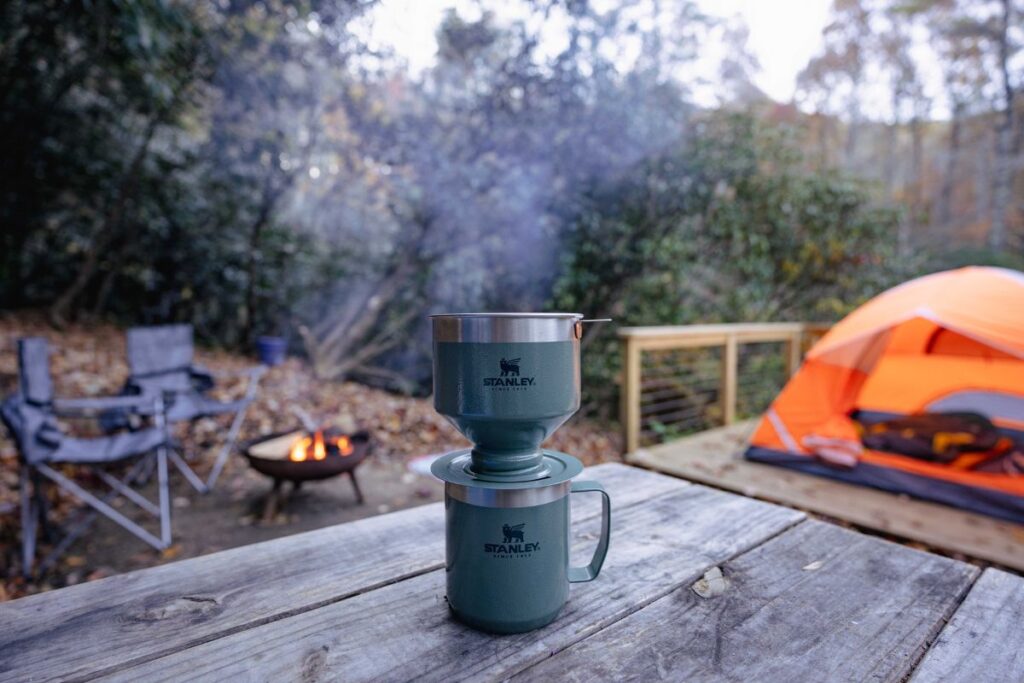
I usually prefer iced coffee, but I love making hot coffee in the morning when I’m camping in cold weather. The Stanley Pour Over Set is my favorite way to make coffee at a campsite. I don’t love black coffee, so I bring creamer from home by putting it in a mason jar and storing it in my cooler.
This pour over set doesn’t require a filter, and you can use your preferred coffee grounds. Coarser grounds will help ensure you don’t get grounds in your coffee. Bonus: The pour over set is super easy to clean!
Other great drinks for cold weather include hot apple cider, hot cocoa, and tea. It’s best to avoid alcohol when you’re camping in the cold because it impacts your body’s ability to regulate its temperature.
# 15: Test your gear before jumping off the deep end
If you’ve never camped in the cold before, it’s probably not the best idea to start with a multi day camping trip in freezing temps. Instead, start small with something like a one-night trip with overnight temps in the 40s/50s.
Testing your gear over time in progressively colder weather allows you to make adjustments as needed instead of learning the hard (and potentially dangerous) way!
SAVE & SHARE THIS POST
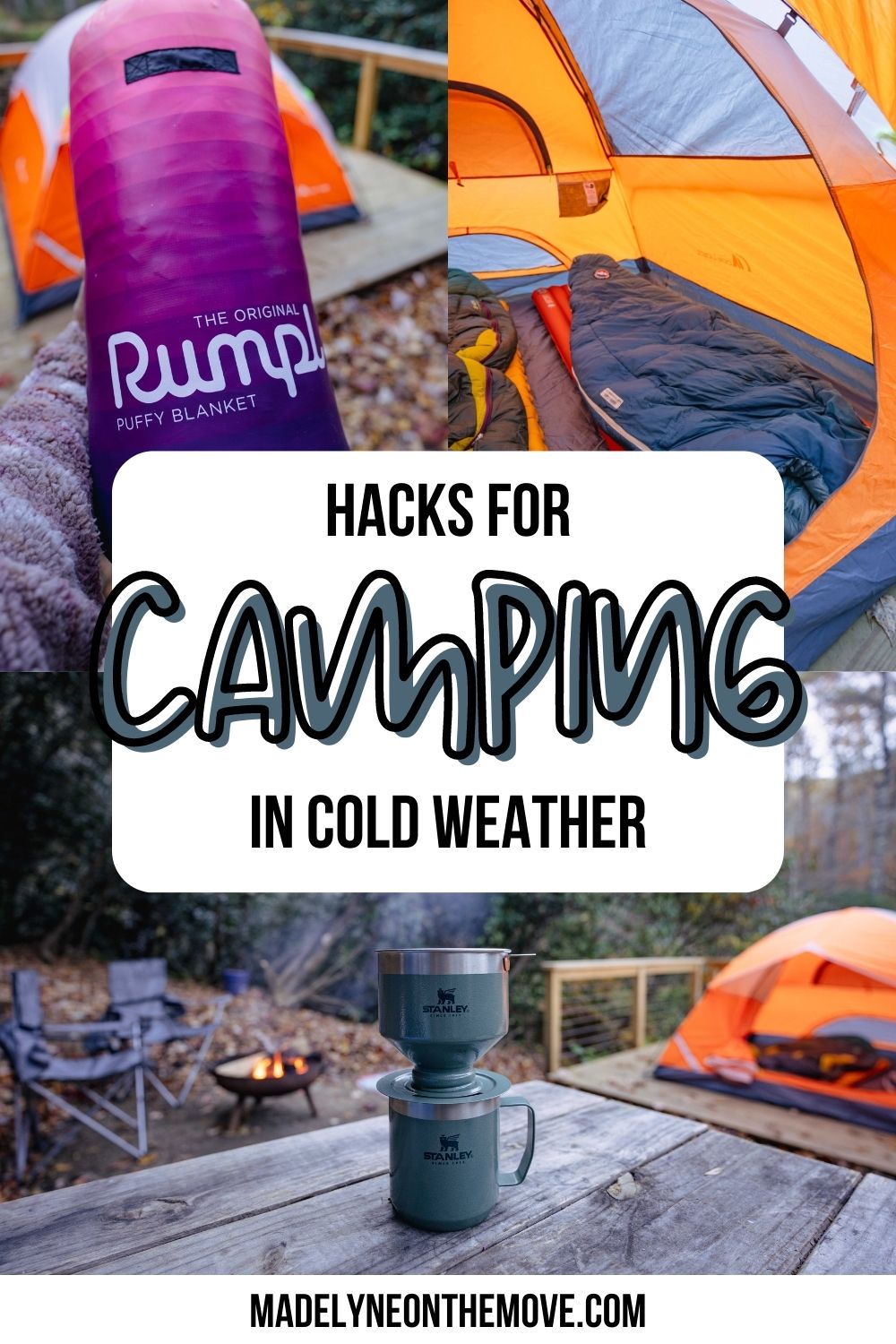
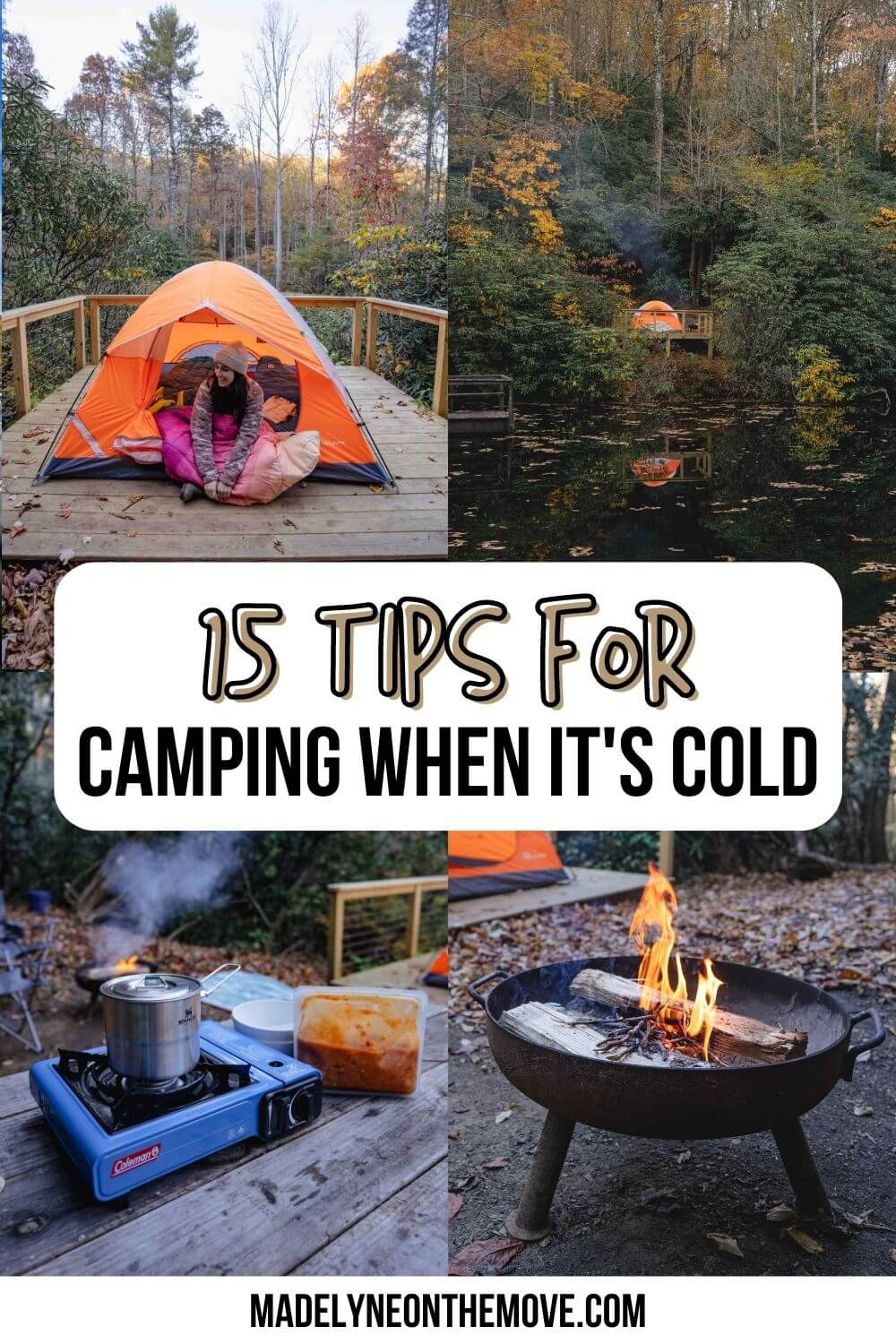
Have you ever gone tent camping in cold weather? Tell me about your experience in the comments, and let me know if I left any hacks for keeping warm in a tent off this list!
